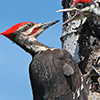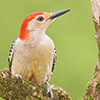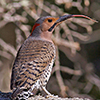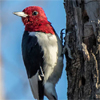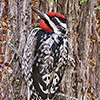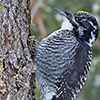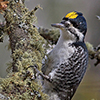
Some Minnesota birds are inclined to migrate south for the winter. They risk their lives undertaking perilous journeys across states, countries, and even entire continents and oceans, determined to avoid the imminent cold and desolation of winter in the northern latitudes in favor of more temperate conditions.
Yet some birds stick out our Minnesota winters with us. No fair-weather fans, these creatures rival and even surpass the hardiest of humans as we await the coming warmth of spring. Among these overwintering birds is a group that is likely familiar to just about anyone with an eye to the outdoors: the woodpeckers. Nine woodpecker species not only breed in Minnesota but also spend the winters here at least in small numbers, forgoing the long-distance migrations of less hardy birds. In mid- to late winter, their drumming calls—made by rapidly striking their chisel-like beaks against standing and fallen trees—signal warmer months ahead long before other birds have begun to head back north.
Woodpecker Conflicts
Please see the Woodpecker Control tab below to learn how to prevent and manage woodpecker conflicts.
Three of these species—the downy, hairy, and red-bellied woodpecker—can be observed from the comfort and warmth of our own homes, as they are ubiquitous throughout most of the state and reliably found at bird feeders. Another four species—the pileated and red-headed woodpecker, the northern flicker, and the yellow-bellied sapsucker—might require a little more luck and persistence to find, with the red-headed woodpecker and yellow-bellied sapsucker being rather scarce most winters. The remaining two species—the black-backed and American three-toed woodpecker—are much-sought-after residents of northern Minnesota's boreal habitats and are the ultimate prize for the motivated (and bundled-up) observer in the dead of winter.
Pileated Woodpecker
There is no mistaking our largest woodpecker by either sight or sound. Roughly the size of a crow, the pileated woodpecker (Dryocopus pileatus) is a true showstopper. With a flaming red crest, dagger-like beak, jet-black body with white racing stripes running up its neck and head, red mustache (black in females), and white wing patches especially visible in flight, this bird really stands out. Its voice is just as exuberant, characterized by a loud, ringing series of keek notes or sometimes singular chicken-like clucks. When the pileated woodpecker drums, the powerful knocks can be heard from quite a distance and can be mistaken for construction equipment.
To see this behemoth, spend time near larger, mature woodlands, which is where it finds trees large enough to excavate its nesting cavities with an entrance hole of four inches in diameter. Your chances of seeing one on a stroll through the woods increase greatly in winter as deciduous trees go bare, offering less obstructed views into the forest. You may even see a pileated woodpecker visit a suet feeder, often dwarfing the feeder itself.
Downy Woodpecker
Likely the best-known of Minnesota's woodpeckers, the downy woodpecker (Picoides pubescens) is also our smallest, reaching a length of under seven inches as an adult. A common winter visitor to bird feeders, especially suet feeders, this woodpecker can be spotted just about anywhere near trees, where its natural food source is found. As a woodpecker forages, clinging to the trunks and thicker branches of trees, it makes frequent jabs into the bark with its beak, probing for insects and their larvae. When a meal is discovered, the bird continues to bore into the bark until it can extract and eat the morsel.
Like all woodpeckers, the downy is a cavity nester, using its short beak to drill into trees and excavate a hole in which to make a nest. Males can be separated from females by the color of the nape or the back of the head. In males, there is a bright red patch here, whereas in females this same area is black like the rest of their patterned plumage. Both sexes frequently give sharp, emphatic chik notes or a longer series of descending notes of similar quality.
Hairy Woodpecker
As common as its smaller relative, the hairy woodpecker (Picoides villosus) is basically a larger version of the downy. Although the size difference is significant, telling these two species apart can be difficult when they're not near each other. The hairy woodpecker has a longer beak than the downy, about equal in length to the width of its head when viewed from the side. (The downy's beak is shorter than the width of its head.) The outer tail feathers of a hairy are completely white, whereas these same feathers on a downy are spotted with black. Like the downy, male hairy woodpeckers have a red patch on their napes and females don't.
One might expect that a bigger bird would have a deeper voice. Not so with the hairy. Instead, its call note is higher in pitch than that of the downy woodpecker, and that is another good way to tell the difference—with practice, of course. In addition, the hairy's longer series of notes does not descend like the downy's does. Especially in late winter, listen for both of these species calling and drumming in your neighborhood as the birds begin to establish breeding territories.
Red-Bellied Woodpecker
Bird names don't always seem to make sense, and the red-bellied woodpecker (Melanerpes carolinus) is a prime example. One of the bird's most obvious traits is the thick red stripe that continues from its beak, over the top of its head, and down its hind neck to where the black-and-white barring of its back begins. Shouldn't this bird be called the red-headed woodpecker? One would think so, but that name is reserved for a different species that has an entirely red head. Instead, the red-bellied woodpecker is named for the pinkish patch of feathers in the center of its belly, which isn't always easy to see in the field.
The red-bellied woodpecker is a common resident of the southern two-thirds of the state, often visiting bird feeders like the previous two species. It is increasingly seen in the northern third of the state as well. Historically more abundant in warmer climates to the south, the red-bellied woodpecker—along with several other bird species—is taking advantage of warmer winters resulting from climate change and surviving colder temperatures by supplementing its natural food with birdseed and suet, enabling its populations to expand northward in Minnesota and elsewhere.
Northern Flicker
Our second-largest woodpecker, the northern flicker (Colaptes auratus) is a short-distance migrant, meaning that a majority of the birds leave Minnesota to spend the winter in states farther south but do not leave the North American continent like long-distance migrants. Some flickers overwinter in Minnesota, so this species can be found statewide even during the cold months. Look for them in more open habitats than most of our other woodpecker species. Northern flickers also frequent suet feeders in winter.
Although all woodpeckers have very long tongues that, when retracted, wrap around their skulls, the northern flicker has one of the longest tongues in the bird world. In warmer months, the flicker uses its projectile-like tongue to lap up ants off the ground like an anteater or aardvark. This is why you'll more often see flickers hopping around lawns and gardens like robins than clinging to tree trunks like other woodpeckers. In flight, our flickers show flashes of yellow under their wings and tails, which is why they're sometimes called yellow-shafted flickers. In western North America, flickers have grayer faces and flashes of red under their wings and tails; they're often referred to as red-shafted flickers.
Red-Headed Woodpecker
The red-headed woodpecker (Melanerpes erythrocephalus) is not our only woodpecker with a lot of red on its head. However, as an adult its head is entirely crimson-red, which makes it most deserving of its common name. This striking feature and a contrasting pattern of black-and-white body plumage make this bird one of our most visually distinctive woodpeckers. Unfortunately, the species has declined in numbers over the past several decades in Minnesota and elsewhere as dead trees, which it uses for nesting, have been largely removed. Red-headed woodpeckers are also frequently associated with oak-savanna habitat characterized by grassy understories and large, scattered oak trees. This habitat, like our native prairie, continues to be degraded and developed.
In most years, when a majority of oaks are producing acorns, red-headed woodpecker populations will remain in their breeding areas, mostly in the southern and western halves of the state, throughout winter. In any given year, some will winter elsewhere in southern Minnesota, but in most winters these woodpeckers are very difficult to find as the majority of birds have headed further south. If you happen to live near a breeding population, you might find that this bird appreciates a suet or citrus fruit supplement to its diet.
Yellow-Bellied Sapsucker
With perhaps the most amusing name of the group, the yellow-bellied sapsucker (Sphyrapicus varius) lives up to its surname. This bird drills holes in the trunks of trees and feeds on the sap that flows out of them. These holes are positioned so uniformly that the bark of a tree can appear to be punctured like a peg board, a sure sign that a sapsucker has been there. Although its body is patterned in black and white similar to a downy or hairy, the similarities stop there. The entire top of its head is bright scarlet and its throat is either the same vibrant color (males) or white (females). The yellow color of the belly can be rather faint but is sometimes bright if viewed head-on.
Like the previous two species, the yellow-bellied sapsucker is a short-distance migrant. Some individuals—often juveniles that haven't quite figured out what to do when it gets cold outside—attempt to remain in the state throughout winter, feeding on crab apples or other fruits in addition to seeds and suet at bird feeders. The first migrants usually return by late March, and this species can be rather common and vocal in some areas by mid-April.
Black-Backed and American Three-Toed Woodpeckers
The most northerly of our woodpeckers, black-backed and American three-toed woodpeckers (Picoides arcticus and Picoides dorsalis, respectively) are best looked for in winter when our local breeders have been joined by opportunistic wanderers from Canada. Sometimes found in more upland coniferous habitats, these two woodpeckers are bog birds more often than not, drilling into the wood of spruces, tamaracks, and other lowland conifers in search of beetle larvae. They almost never visit feeders, which means that to see one you'll have to venture into their habitat. Although the two species look similar, they can be told apart by their backs. The black-backed, as its name implies, has solid black upperparts whereas the American three-toed has white barring down its back. The black-backed is also slightly larger with a longer beak than the American three-toed, and the American three-toed is much scarcer.
Both species are attracted to recently burned forests where they feed on abundant invertebrates and make their nesting cavities. As the abundance of prey declines, the birds move on. The species' ecology is closely tied to the natural cycle of forest fires, which means efforts to suppress fires have had a negative impact on the birds' populations. A recent proposal to list two black-backed woodpecker populations under the Endangered Species Act underscores this relationship.
As spring is nigh, the woodpeckers with which we shared our Minnesota winter are attracting mates and looking ahead to the nesting season. Indeed, there seems to be no vacation for these birds or any others that successfully survived the hardships of winter.
(originally published in the Minnesota Conservation Volunteer)
- Woodpecker Control
- Several tactics may be used to discourage woodpeckers from damaging your house. Plug and camouflage existing holes with rope caulk, silly putty, floral clay, or similar material. Be sure to seal tunnels used by leaf-cutting bees to exclude them.
Visual or sound repellents should be used as soon as possible before the birds’ territories become well established. Visual repellents include plastic toy twirlers (whirligigs), windmills, hanging pie pans, hanging aluminum foil streamers 2 inches wide by 3 feet long, and Bird Scare reflecting tape.
Bird Scare Balloons – Place balloon in front of the affected wall or area. Leave the balloon up for about a week. Balloons are reusable and cost about $13. They are available at larger garden centers, hardware stores and stores specializing in feeding wild birds.
Bird Scare Tape (also called Flash Tape, reflecting mylar tape). Tack and suspend several long streamers (6’ to 8’) above the affected surface about a foot apart. It is important that they move in the wind. Or arrange tape in horizontal rows over the affected area, suspending it away from the wall a bit, keeping it as taut as possible and twisted so both colors show. You may also try placing tall stakes or rods next to the wall and stringing the tape back and forth from stake to stake. The tapes costs about $5 per roll and is available at larger garden centers, hardware stores, and bird feeding stores.
Fake Owls —Available at sporting goods/hunting supply stores. Place 10-15’ high in visible spot, on edge of house roof, upper deck railing, etc. There are a few different types of plastic owls available, some of which have a mechanical head that moves and makes noise to scare birds away. These may negatively affect birds coming in to a backyard feeding station. The owls range in price from about $12 - $50.
Pie Tins and CDs —Attach pie tins or old, unusable CDs to a string, and hang in front of affected areas. Tins and discs should spin in the wind.
Linseed oil —Best for small pea-sized holes. Fill a hand-held oil can with linseed oil, an oil base for wood stains. Squirt a small amount of linseed oil in each opening. This kills the insects that are attracting the woodpeckers. Fill in hole with color-matched wood putty.
Wood Treatments- Cedar siding often attracts insects that woodpeckers are drilling to get at. Seal all openings in siding with caulking to keep insects to a minimum. Look for a wood stain or preservative that kills insects, which will deter the woodpeckers. Sticky anti-roosting treatments may also keep woodpeckers away.
Another option, especially if you are a bird enthusiast, is to provide an alternate drumming site away from houses. Attach two overlapping boards together and securely fasten the back board to a solid post, tree trunk, or other sturdy support. This provides a drumming site with pleasing resonance for woodpeckers.
When woodpeckers are just drumming, chase them away. Cover or pad objects or areas being drummed, eliminate ledges or cracks used for footholds, apply a sticky substance, such as Tanglefoot to a thin board and tack it where the bird would perch, and cover affected areas with plastic sheeting or netting. When covering areas with netting, prop the net at least one inch away from the surface so the birds can’t peck through it easily. Hardware cloth also works well.
Using suet as an alternative food to lure woodpeckers away from the house is a real gamble, but sometimes works. Suet is not a natural food for woodpeckers, but they may respond to it. However, it could backfire by attracting additional woodpeckers, especially in winter.
Learn more about woodpecker control in this woodpecker control information document.


